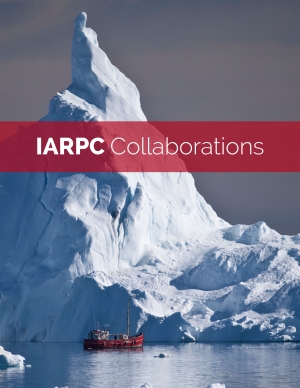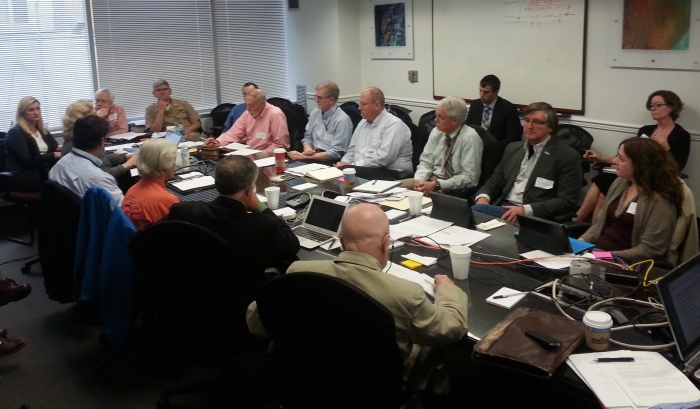By: Sara Bowden, IARPC Executive Secretary; and Jessica Rohde, IARPC Project Coordinator/Web Manager

In 2013, the Principals of the Interagency Arctic Research Policy Committee approved the following vision statement: IARPC envisions a prosperous, sustainable, and healthy Arctic understood through innovative and collaborative research coordinated among Federal agencies and domestic and international partners. The IARPC community has embraced this vision in 2014 and expanded its focus from federal-only discussions to a more collaborative effort that involves both federal and non-federal partners to better harness the talent of the broader scientific and stakeholder community. A number of tools have been put in place in order to enable this far-reaching communication and collaboration. In some cases these tools are tried and true, while others are new, innovative, and even experimental in nature.
Collaboration Teams: The heart of the discussion
The Obama Administration released the five-year Arctic Research Plan: FY2013-2017 in February 2013. The Arctic Research Plan focuses on advancing knowledge of the Arctic by improving collaboration in seven priority research areas (sea ice and marine ecosystems, terrestrial ice and ecosystems, atmospheric studies, observing systems, regional climate models, human health studies, and adaptation tools for communities). From these seven research areas, 12 collaboration teams were formed to respond to the 145 milestones laid out in the plan. The collaboration teams are charged with enhancing inter-institutional and interdisciplinary implementation of scientific research on local, regional, and circumpolar environmental and societal issues in the Arctic.
The collaboration teams are chaired by Federal program managers, and in some cases co-chaired with an external partner. They meet on a regular basis by teleconference or screen-sharing to inform one another about ongoing and planned programs and new research results, as well as to inventory existing programs, identify gaps in knowledge and research, and address and implement the plan’s milestones. These conversations are open to researchers in state agencies, local communities, research labs, non-governmental organizations (NGOs), industry, and universities. All meetings of the collaboration teams are announced on the new IARPC collaborations website.
Innovative Tools
IARPC Collaborations Website
In October 2014, IARPC launched a new website to advance the way researchers collaborate. Entitled "IARPC Collaborations," this website is an experiment in new ways to "do" science, an effort to help funders and researchers work together across agencies, sectors, and disciplines. Anyone in the Arctic research community can request an account on the member space, including non-federal and international partners. These members then contribute information about their research activities by posting their own updates, documents, and events. Members comment on each others' posts to create a dialogue about research in an open forum that includes contributions from new members of the community. IARPC Collaborations leverages social media to:
- Foster dialogue in an open forum where new collaborators can contribute;
- Give researchers the power to share information themselves, without going through a webmaster;
- Bring each member an individually customized email digest of website posts based on their research interests and at the frequency of their choosing; and
- Curate a crowd-sourced "dictionary" of acronyms related to Arctic research and policy.
Everyone in the Arctic research community is invited to join the conversation by establishing an IARPC Collaborations account here. For more information contact full-time Web Manager, Jessica Rohde (rohdej [at] arcus.org).
Webinars
IARPC collaboration teams recognize that to implement the Arctic Research Plan, Federal program managers and the research community must learn from one another. Therefore, many of the teams are using short informational webinars to highlight new research results, datasets, models, etc. These webinars are announced on the IARPC collaborations website, open to the research community, and recorded and posted so that they can be viewed at any time. Webinars have covered topics such as black carbon, ice sheets in coupled climate models, the Marginal Ice Zone field experiment, food security, satellite data visualization for the Distributed Biological Observatory, and development of the Terrestrial Ecosystems Observing Network.

Evaluation and Evolution
In an effort to provide the collaboration team leads with the opportunity to learn more about each other and discuss future information sharing and collaboration among teams, a face-to-face meeting was held 4-5 November 2014 in Washington, D.C., eighteen months after most of the teams had been created. The meeting provided an opportunity to discuss current team successes, challenges, and opportunities; and reflect on how to improve internal and external communication, including expanding the IARPC information sharing network. Through a series of whole and small group discussions and activities focused on the various teams’ successes and challenges, team leaders generated a list recommendations to make IARPC collaborations more successful and to better accomplish the many and varied IARPC research milestones. Facilitated activities ranged from discussions on each team’s strengths and how they might be replicated in other teams, to comparing and contrasting individual team challenges. The teams also reviewed approaches to increasing effective participation at both Federal and non-federal levels, which included a review of the IARPC collaborations website. A public summary of the workshop can be found here.
Forging New Ground with Many Partners
Simon Stephenson is the current Executive Director of IARPC and Assistant Director for Polar Science in the White House Office of Science and Technology Policy (OSTP). Stephenson brought his knowledge of the Arctic research enterprise garnered over many years at the National Science Foundation (NSF) to this position in July 2014 following the departure of Brendan Kelly. Early in his tenure as Executive Director, Stephenson said, "The U.S. Government supports research that increases our knowledge of our changing planet. In the last five years we have increased attention on coordinating Federally funded research in the Arctic that helps with this understanding. While IARPC is a government committee, the collaboration teams are not. They combine the expertise and talents of U.S. government program managers and scientists with those of researchers in academia, state and local government, industry, non-profits, and the increasingly critical involvement of local communities in the research enterprise. We are forging new ground by providing tools to share information and enter into dialogue with research partners in a way which I believe will yield good results in the years ahead." Stephenson and the Collaboration Team leaders invite the Arctic research community to engage in discussions and collaborations taking place on the IARPC Collaborations website.
More information about IARPC is available here. For questions, contact IARPC Executive Secretary Sara Bowden (bowden [at] arcus.org).
More information about the IARPC Collaborations website is available here. For questions, contact IARPC Project Coordinator/Web Manager Jessica Rohde (jrohde [at] mail.arcus.org).
